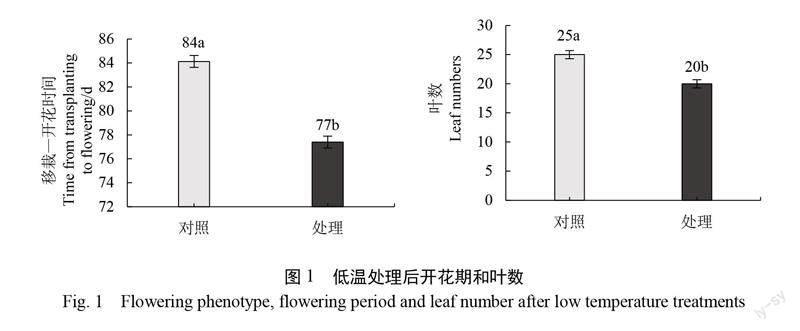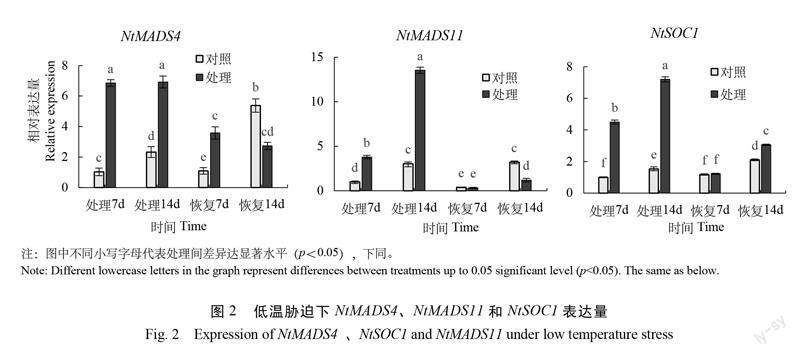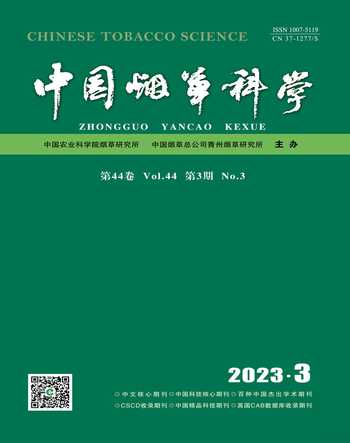低溫脅迫下煙草開花調控基因表達分析
姜習振 楊晨凱 鄒湘香 李洋洋 張慶富 任曉敏 晏偉杰 姚未遠 賀新穎 胡日生 戶正榮



摘要:為了探究低溫脅迫誘導煙草早花的分子機制,以低溫敏感品種云煙87為試驗材料,在12 ℃低溫條件下處理煙苗14 d ,取莖頂端組織進行煙草開花調控基因分析,并調查統(tǒng)計了煙株中心花開放時間和葉數(shù)。結果顯示,與對照相比,低溫脅迫導致煙株中心花開放時間平均提前7 d,葉數(shù)平均減少5片。基因表達分析結果表明,低溫脅迫下開花調控基因NtMADS4, NtMADS11,NtAP1,NtSOC1,NtFUL,NtNFL1,NtFT1,NtFT3,NtFT4,NtFT5表達水平明顯高于對照,在正常環(huán)境中恢復生長7~14 d,表達量下降至與對照相近的水平。以上結果表明,低溫誘發(fā)煙草早花可能與這些基因上調表達有關。
關鍵詞:煙草;低溫脅迫;早花; MADS-box 家族;NtFTs;基因表達
中圖分類號: S572.03???????? 文獻標識碼: A???????? 文章編號:1007-5119(2023)03-0010-06
Expression Analysis of Flowering Regulatory Genes in Tobacco under Low Temperature Stress
JIANG Xizhen1, YANG Chenkai1,2, ZOU Xiangxiang3, LI Yangyang2, ZHANG Qingfu4, REN Xiaomin5, YAN Weijie6, YAO Weiyuan4, HE Xinying4, HU Risheng2, HU Zhengrong2*
(1. College of Agronomy, Hunan Agricultural University, Changsha 410128, China;2. Hunan Tobacco Research Institute, Changsha410004, China;3. China Tobacco Hunan Industrial Co., Ltd., Changsha 410007, China;4. Ningxiang Branch of Changsha TobaccoCompany, Changsha 410600, China;5. Institute of Bast Fiber Crops, Chinese Academy of Agricultural Sciences, Changsha 410205,China;6. Shimen County Branch of Changde Tobacco Company, Changde, Hunan 415300, China)
Abstract: To investigate the molecular regulatory mechanism of low temperature induced early flowering, a cold-sensitive tobacco cultivar Yunyan 87 was treated with cold stress of 12 ℃ for 14 days. The shoot apical tissues of plants were collected for flowering-regulatory gene expression analysis. The time of central flower opening and the total number of leaves were investigated. The results showed that central flower opening date of the cold-treated tobacco plants was 7 days earlier than that of the control, and total leaf number of the treated plants was 5 leaves less than that of the control. Besides, the expression levels of 10 flowering-regulatory genes were increased by cold stress when compared to the control, including NtMADS4, NtMADS11, NtAP1, NtSOC1, NtFUL, NtNFL1, NtFT1, NtFT3, NtFT4 and NtFT5; and then decreased to similar levels of the control after recovery under normal conditions for 7-14 days. These results suggested that cold-induced tobacco early flowering may be related to the up-regulation of these flowering regulatory genes.
Keywords: tobacco; low temperature stress; early flowering; MADS-box family; NtFTs; gene expression
煙草屬喜溫作物,連續(xù)低溫會導致其早花[1],達不到應有的株高、葉數(shù)和葉片大小[2],嚴重影響煙草產質量[3]。探索低溫脅迫下煙草基因表達變化,闡明低溫早花的分子調控機理,對選育耐低溫抗早花煙草品種具有重要意義。
MADS-box 家族基因在生殖生長調控中起到了非常重要的作用[4-5]。AGL2亞家族的 NtMADS4基因和 SQUA(squamosa)亞家族的 NtMADS11基因參與花分生組織和花器官的識別。過表達NtMADS4和 NtMADS11基因均會導致煙草提前開花[6-8]。 SOC1 (suppressor of overexpression of constans 1)也屬于 MADS-box 基因家族,在擬南芥中過表達白菜 BrcSOC1導致轉基因植株開花時間顯著早于野生型[9]。由 FT(flowering locus T)基因編碼的 FT 蛋白是成花素的主要成分[10],Harig 等[11] 在煙草中鑒定到4個FT 基因NtFT1、NtFT2、NtFT3、NtFT4,發(fā)現(xiàn) NtFT1、NtFT2、NtFT3抑制煙草開花,而 NtFT4則誘導開花。高玉龍等[12]發(fā)現(xiàn)擬南芥 FT 基因在烤煙品種中的瞬時表達導致煙草早花。AP1(apetala1)和 FUL(fruitfull)在花分生組織轉換過程中起著重要的調控作用[13],研究發(fā)現(xiàn)在煙草中過表達NtFUL和楊樹 PsnAP1基因,均能導致煙草早花[14]。煙草 NtNFL1是擬南芥 LFY (leafy)的同源基因,NtNFL1與NtAP1都是分生組織特異性基因,并且 NtNFL1基因起著調控花器官形成和莖側端分生組織形成腋芽的作用[15]。目前關于低溫脅迫下煙草開花調控基因表達模式的相關研究卻少有報道。
烤煙品種云煙87易受低溫誘導開花[16],本研究以云煙87為試驗材料,利用qRT-PCR 技術對 NtMADS4、NtMADS11、NtSOC1、NtFT1、NtFT3、 NtFT4、NtFT5、NtAP1、NtFUL、NtNFL1共10個煙草開花調控基因在正常條件和低溫脅迫下的表達模式進行分析,旨在探究煙草低溫早花調控機制,為培育耐低溫抗早花烤煙新品種提供理論參考。
1 材料與方法
1.1 試驗材料及種植培養(yǎng)
本試驗采用的煙草品種為云煙87,由中國煙草中南農業(yè)試驗站提供。種植于湖南省煙草科學研究所人工氣候室。種子清洗后放入2 mL 離心管中,加入1.5 mL 無菌水,于4℃冰箱中處理2 d,以促進種子發(fā)芽同步化。在容積為1 L 的底部有透水孔的方盒中裝入煙草育苗基質,放置于水中,讓基質充分吸收水分。種子在冰箱中處理完成后,均勻地撒播于基質上。種子萌發(fā)并生長至兩片子葉完全展開時,選取健康幼苗定植于上述基質盒中,在25℃、相對濕度65%、光照16 h/d 條件下培養(yǎng)至苗齡41 d (7葉),開始處理。
1.2 試驗處理
挑選長勢一致的煙苗,分為2組。處理組:煙苗在人工氣候室中12℃低溫處理14 d,然后在常溫25℃條件下恢復14 d,期間相對濕度保持在65%、光照16 h/d。對照組:煙苗一直在正常條件下(25℃ , 相對濕度65%、光照16 h/d)培養(yǎng)。處理組和對照組的煙苗每7 d 取一次樣用于基因表達分析。具體取樣方法:取煙苗莖頂端組織(包含頂端3片幼葉),迅速用錫紙包好并放入液氮速凍,立即于-80℃冰箱中保存。每3株混合作為一個生物學重復,每組3個生物學重復。其他煙株(處理組和對照組均預留15株)用于開花期和葉數(shù)的調查統(tǒng)計。
1.3 RNA 提取和反轉錄
采用朱曉宇等[17]改進的 CTAB 法提取 RNA 。 RNA 反轉錄參照iScript? gDNA Clear cDNA Synthesis Kit 說明書進行。
1.4 qRT-PCR 相對定量
采用 ABI 公司生產的QuantStudio 6 Flex 熒光定量 PCR 儀,使用 Takara 公司生產的 SYBR Premix EX Taq 對各基因的表達量進行 qPCR 檢測,以NtActin為內參基因。 qPCR 所用引物信息見表1。
qRT-PCR 反應體系:2×qPCR Mix 10?L、上下游引物(10?mol/L)各0.5?L、cDNA 0.5?L,ddH2O 補足至20?L。反應條件:95℃預變性5 min;95℃變性10 s、60℃退火延伸30 s,40個循環(huán);溶解曲線采集階段95℃15 s ,60℃60 s ,95℃15 s。
1.5 數(shù)據(jù)分析和處理
用 SPSS 19軟件進行數(shù)據(jù)多重比較及差異顯著性檢測,p<0.05,用 Excel 2016作圖。
2 結果
2.1 低溫脅迫后開花期及葉數(shù)
由圖1可見,云煙87在經過14 d 的低溫處理后,平均提前7 d 開花,顯著早于對照。同時,低溫處理的葉片平均減少5片,顯著少于對照。表明,低溫脅迫會導致敏感煙草品種提前開花,葉數(shù)減少。
2.2 低溫脅迫后開花調控基因表達分析
以常溫為對照,對煙株低溫(12℃)處理7 d、14 d 和常溫(25℃)恢復后7 d、14 d 進行表達量測定。結果顯示(圖2),對照組 NtMADS4的表達量前期一直處于較低水平,后期明顯升高。與對照組相比,NtMADS4受低溫脅迫顯著上調表達,恢復7 d 時表達量有所下降但仍高于對照,恢復14 d 后其表達水平明顯低于對照。NtMADS11在低溫處理時表達量上調并于14 d 時達到峰值,是對照組的4.5倍,常溫恢復后表達量明顯下降,在恢復14 d 時其表達水平顯著低于對照。此外, NtSOC1在低溫處理后上調表達,在處理14 d 時達到峰值,其表達量是對照組的4.7倍,常溫恢復后 NtSOC1表達量下降,與對照的差值逐漸減小。綜合來看,在低溫處理下 NtMADS4、NtMADS11和 NtSOC1的表達量均顯著高于對照,而常溫恢復后其表達量便明顯降低。表明,正常條件下 NtMADS4、NtMADS11和 NtSOC1在苗期維持在較低水平,但低溫脅迫會誘導上調表達。
如圖3所示,對照組的 NtFT1、NtFT3、NtFT5在4個時間點的表達量均處于較低水平, NtFT4在7 d 時的表達量較高,隨后也降至較低水平。但與對照組相比,低溫處理組 NtFT1、NtFT3、NtFT4和 NtFT5表達量明顯升高,其中 NtFT1、NtFT4和 NtFT5在低溫處理7 d 時達到峰值, NtFT3在處理14 d 時達到峰值。在正常條件下恢復后,這4個NtFT基因的表達量明顯下降至與對照組相近的水平。以上結果表明,正常條件下4個 FT 基因的表達量維持在較低水平,但低溫脅迫會特異性激活其表達。
如圖4所示,與對照組相比,低溫處理后 NtAP1、NtFUL和 NtNFL1表達量均升高, NtAP1、NtFUL在處理14 d 時達到峰值,NtNFL1在處理7 d 達到峰值。3個基因表達量在常溫恢復后下降至與對照組相近水平。該結果表明,低溫脅迫會激活 NtAP1、NtFUL和 NtFL1基因表達,在常溫恢復后其表達量會恢復至正常水平。 AP1、FUL 同屬于 MADS-box 基因家族中的 AP1/FUL 亞家族,處于開花調控途徑的下游,起著整合開花信息的作用。
3 討論
植物根據(jù)內源和環(huán)境信號調整花期轉換[18],一些 MADS-box 基因的過表達會增強其他內源開花相關基因的表達,誘導煙草提前開花[19]。前人研究發(fā)現(xiàn),過表達 PsnAP1 的煙株中 NtMADS4 和 NtMADS11的表達量均比野生型高出10倍[14]。本研究結果發(fā)現(xiàn),NtMADS4和 NtMADS11基因均受低溫脅迫上調表達,其中 NtMADS11在低溫處理14 d 時的表達量上調了14倍。因此,推測 NtMADAS4和 NtMADS11可能參與了低溫誘導煙草早花調控過程,但其具體的作用機理還需進一步探究。SOC1作為開花調控整合因子,既受 FLC(flowering locus C)調控參與春化成花途徑,亦受 FT 和 FD 蛋白結合的復合體調控參與光周期成花途徑[20]。本研究發(fā)現(xiàn) NtSOC1基因表達量在低溫處理后上調,處理14 d 時達到峰值,但常溫恢復后其表達量又迅速降低,這充分說明 NtSOC1的表達受低溫誘導。
FT 基因受 CO 信號和 FLC 調控,進而激活 SOC1和 AP1的表達誘導植物開花,在光周期途徑和春化途徑促進開花過程中起到關鍵作用[21]。前人研究表明,NtFT1、NtFT2和 NtFT3是開花抑制子,僅有 NtFT4為開花誘導子[11]。本研究發(fā)現(xiàn),在低溫脅迫下,NtFT1、NtFT3、NtFT4的表達量迅速上調,且NtFT1、NtFT3和NtFT5的表達量明顯高于NtFT4,但 FT 下游的 SOC1卻上調表達,且植株開花明顯提前。NtFT1、NtFT3和 NtFT4通過競爭 FD 蛋白來共同調控下游基因[11],研究發(fā)現(xiàn), FD 蛋白會更傾向于與開花誘導子NtFT4結合來激活下游基因的表達,進而使 NtFT4在蛋白質水平上比其他抑制子更具有競爭力[22]。本試驗中低溫處理階段 NtFT4的表達量在7 d 時達到峰值后呈下降趨勢,而 NtSOC1 則是逐步上調表達,在14 d 達到峰值,推測 NtFT4 迅速響應低溫并先于 NtSOC1上調表達。 NtFT5也是開花誘導基因,它的表達幾乎不受光周期的影響,在開花過程中起著比 NtFT4更重要的作用[22]。本研究發(fā)現(xiàn),NtFT5在低溫處理時有較高的表達量,常溫恢復后表達量下降至對照水平,說明 NtFT5同樣受低溫誘導,與 NtFT4共同激活下游基因表達,促進植物成花。
AP1處于各種成花途徑調控的下游,并在誘導開花的調控中起到核心作用。AP1可以被 FT-FD 和 LFY 激活表達,從而促進成花[23]。FUL 基因編碼一個含有 MADS 結構域的轉錄因子,來促進花分生組織識別和花期轉換[24]。NtFUL基因受 FT-FD 復合體的誘導表達參與成花,且其表達量會隨著煙株的生長發(fā)育逐漸升高,并在成花階段維持較高表達量[14,25],在本試驗中, NtAP1、NtFUL基因均受低溫脅迫上調表達,其表達水平顯著高于對照;正常溫度恢復后,其表達量與對照之間的差值縮小且保持上升趨勢,推測低溫會誘導 NtAP1和NtFUL的表達,并且其表達量隨著煙株生長發(fā)育而逐步上調,在進入花器官的識別和建成階段時達到最高水平,從而促進植物開花。 NtNFL1同樣受低溫誘導而高量表達,并在正常溫度恢復后表達量降低至對照水平,其變化趨勢與 NtFT4和 NtFT5相似,不同于 NtSOC1、NtAP1和NtFUL。NtNFL1的表達受 FT-FD 復合物和NtSOC1的調控,相比于NtAP1和NtFUL, NtNFL1可能更易被NtFTs基因激活。
4 結論
本研究驗證了低溫脅迫會誘導敏感煙草品種提前開花導致葉數(shù)減少,發(fā)現(xiàn)低溫脅迫會誘導開花調控基因 NtMADS4,NtMADS11,NtSOC1,NtFT1, NtFT3,NtFT4,NtFT5,NtAP1,NtFUL,NtNFL1的表達。低溫誘導煙草早花具體的調控機制還需要通過基因敲除或過表達等方式來進一步探究。
參考文獻
[1] 白戈,楊大海,姚恒,等.煙草耐低溫脅迫早花突變體材料的篩選[J].分子植物育種,2019,17(13):4410-4415.
BAI G, YANG D H, YAO H, et al. Screening of tobacco early flowering mutants resistant to low temperature stress[J]. Molecular Plant Breeding, 17(13):4410-4415.
[2] 金磊,晉艷,周冀衡,等.苗期低溫對烤煙花芽分化及發(fā)育進程的影響[J].中國煙草科學,2007(6):1-5.
JIN L, JIN Y, ZHOU J H, et al. Effects of low temperature in seedling stage on floral differentiation and development of flue-cured tobacco[J]. Chinese Tobacco Science, 2007(6):1-5.
[3]? HU Z R, YAN W J, YANG C K, et al. Integrative analysis of transcriptome and metabolome provides insights into the underlying mechanism of cold stress response and recovery in two tobacco cultivars[J]. Environmental and experimental botany, 2022, 200:104920.
[4]? ZHANG J Y, MO Z H, LI Y R, et al. Cloning and functional analysis of the MADS-box CiMADS9 gene from Carya illinoinensis[J] Horticultural Plant Journal , 2015, 1(1):11-16.
[5]? LIU X Y, ZHANG D D, YU Z F, et al. Genome-wide identification and analysis of the MADS-Box gene family in almond reveal its expression features in different flowering periods[J]. Genes, 2022, 13(10):1764
[6]? SMYKAL P, GENNEN J, DE B S, et al. Flowering of strict photoperiodic Nicotiana varieties in non-inductive conditions by transgenic approaches[J]. Plant Molecular Biology, 2007, 65(3):233-242.
[7]? JANG S, AN K, LEE S, et al. Characterization of tobacco MADS-box genes involved in floral initiation[J]. Plant & cell physiology, 2002, 43(2):230-238.
[8]? LIAO W Y, LIN L F, LIN M D, et al. Overexpression of Lilium formosanum MADS-box (LFMADS) causing floral defects while promoting flowering in Arabidopsis thaliana, whereas only affecting floral transition time in Nicotiana tabacum[J]. International Journal of Molecular Sciences, 2018, 19(8):2217.
[9]? LI X, AMIN P, QI X H, et al. Cloning, expression and functional analysis of the SOC1 homologous gene in pak choi (Brassica rapa ssp. Chinensis makino)[J]. Biotechnology & Biotechnological Equipment,2022, 36(1):848-857.
[10] TAOKA K, KOJIMA C, TSUJI H, et al. Structure and function of florigen and the receptor complex[J]. Trends in Plant Science, 2013, 18(5):287-294.
[11] HARIG L, BEINECKE F A, OLTMANNS J, et al. Proteins from the FLOWERING LOCUS T-like subclade of the PEBP family act antagonistically to regulate floral initiation in tobacco[J]. The Plant Journal, 2012, 72(6):908-921.
[12] 高玉龍,肖炳光, RALPH E D.誘導煙草早花的 PVX-FT 系統(tǒng)的建立[J].中國煙草學報,2013,19(6):102-105.
GAO Y L, XIAO B G, RALPH E D. Construction of PVX-FT system that inducing early flowering in tobacco[J]. Acta Tabacaria Sinica, 2013, 19(6):102-105.
[13] ZHANG C L, SUN Y L, YU X M, et al. Functional conservation and divergence of five AP1/FUL-like genes in Marigold (Tagetes erectaL.)[J]. Genes, 2021, 12(12):2011.
[14] ZHENG T C, LI S, ZANG L N, et al. Overexpression of two PsnAP1 genes from Populus simonii × P. nigra causes early flowering in transgenic tobacco and Arabidopsis[J]. PLoS One, 2014, 9(10): e11175
[15] AHEARN K P, JOHNSON H A, WEIGEL D, et al. NFL1, a Nicotiana tabacum LEAFY-like gene, controls meristem initiation and floral structure[J]. Plant & Cell Physiology, 2001, 42(10):1130-1139.
[16] 王欣亞,吳委林,南桂仙,等.25份煙草品種(系)低溫誘導早花耐易性鑒定及分類[J].延邊大學農學學報,2019,41(1):30-40. WANG X Y, WU W L, NAN G X, et al. Identifications and classifications of tolerance of 25 tobacco varieties (strains) induced by low temperature premature premature flowering[J]. Agricultural Science Journal of Yanbian University, 2019, 41(1):30-40.
[17] 朱曉宇,姚珊珊,趙二衛(wèi),等.煙草葉片總 RNA 提取方法的比較[J].安徽農業(yè)科學,2010,38(15):7821-7823.
ZHU X Y, YAO S S, ZHAO E W, et al. Comparison on total RNA extraction methods from tobacco leaves[J]. Journal of Anhui Agricultural Sciences, 2010, 38(15):7821-7823.
[18] DAI G Y, CHEN D K, SUN Y P, et al. The Arabidopsis KH-domain protein FLOWERING LOCUS Y delays flowering by upregulating FLOWERING LOCUS C family members[J]. Plant Cell Reports, 2020, 39(12):1705-1717.
[19] MA G Y, NING G G, ZHANG W, et al. Overexpression of Petunia SOC1-like gene FBP21 in tobacco promotes flowering without decreasing flower or fruit quantity[J]. Plant molecular biology reporter, 2011, 29(3):573-581.
[20] ABE M, KOBAYASHI Y, YAMAMOTO S, et al. FD, a bZIP protein mediating signals from the floral pathway integrator FT at the shoot apex[J]. Science, 2005, 309(5737):1052-1056.
[21] PIN P A, NILSSON O. The multifaceted roles of FLOWERING LOCUS T in plant development[J]. Plant, cell & environment, 2012, 35(10):1742-1755.
[22] BEINECKE F A, GRUNDMANN L, WIEDMANN D R, et al. The FT/FD-dependent initiation of flowering under long-day conditions in the day-neutral species Nicotiana tabacum originates from the facultative short-day ancestor Nicotiana tomentosiformis[J]. The Plant Journal, 2018, 96(2):329-342.
[23] WELLMER F, RIECHMANN J L. Gene networks controlling the initiation of flower development[J]. Trends in Genetics, 2010, 26(12):519-527.
[24] BALANZà V, MARTíNEZ I, SATO S, et al. Genetic control of meristem? arrest? and? life? span? in? Arabidopsis? by? a FRUITFULL-APETALA2 pathway[J]. Nature Communications, 2018, 9:565.
[25] ANDRES F, COUPLAND G. The genetic basis of flowering responses to seasonal cues[J]. Nature Reviews: Genetics, 2012, 13(9):627-639.

